Increase the Efficiency of an Induction Motor Feed from Inverter for Low Frequencies by Combining Design and Control Improvements
Abstract
:1. Introduction
2. Object of Investigation
3. Selection of the Number of Serial Coils and Control Parameters for the SK135/120 Motor with the Use of the Circuit Model
4. Supporting Simulation of the SK 135/120 Motor with the Use of the Field-Circuit Method
5. Conclusions
Author Contributions
Funding
Informed Consent Statement
Conflicts of Interest
References
- Ferreira, F.J.T.E.; Baoming, G.; de Almeida, A.T. Reliability and Operation of High-Efficiency Induction Motors. IEEE Trans. Ind. Appl. 2016, 52, 4628–4637. [Google Scholar] [CrossRef]
- Donolo, P.D.; Pezzani, C.M.; Bossio, G.R.; De Angelo, C.H.; Donolo, M.A. Derating of Induction Motors Due to Power Quality Issues Considering the Motor Efficiency Class. IEEE Trans. Ind. Appl. 2020, 56, 961–969. [Google Scholar] [CrossRef]
- Patil, P.V.; Naveed, S.A. Implementation of VFD Application for Speed Control of Induction Motor. In Proceedings of the 2020 International Conference on Smart Innovations in Design, Environment, Management, Planning and Computing (ICSIDEMPC), Aurangabad, India, 30–31 October 2020; pp. 168–170. [Google Scholar] [CrossRef]
- Bramerdorfer, G.; Lei, G.; Cavagnino, A.; Zhang, Y.; Sykulski, J.; Lowther, D.A. More Robust and Reliable Optimized Energy Conversion Facilitated through Electric Machines, Power Electronics and Drives, and Their Control: State-of-the-Art and Trends. IEEE Trans. Energy Convers. 2020, 35, 1997–2012. [Google Scholar] [CrossRef]
- Stich, F.A. Transistor Inverter Motor Drive Having Voltage Boost at Low Speeds. U.S. Patent No. 3,971,972, 27 July 1976. [Google Scholar]
- Shonin, O.B.; Novozhilov, N.G.; Kryltsov, S.B. Sensorless estimation of the rotor speed for the use in V/f control systems of IM drives. In Proceedings of the 2016 2nd International Conference on Industrial Engineering, Applications and Manufacturing (ICIEAM), Chelyabinsk, Russia, 19–20 May 2016; pp. 1–4. [Google Scholar] [CrossRef]
- Ito, T.; Nakamura, Y.; Mohri, K.; Uchiyama, T. Accurate Low-Speed and Torque Controls for Induction Motor with Secondary Current Feedback Using MI Sensor Installed in Shaft Hole. IEEE Trans. Magn. 2006, 42, 3515–3517. [Google Scholar] [CrossRef]
- Balasubramanian, A.; Martin, F.; Billah, M.M.; Osemwinyen, O.; Belahcen, A. Application of Surrogate Optimization Routine with Clustering Technique for Optimal Design of an Induction Motor. Energies 2021, 14, 5042. [Google Scholar] [CrossRef]
- Stopa, M.M.; Resende, M.R.; Luiz, A.A.; Justino, J.C.G.; Rodrigues, G.G.; Cardoso Filho, B.J. A Simple Torque Estimator for In-Service Efficiency Determination of Inverter-Fed Induction Motors. IEEE Trans. Ind. Appl. 2020, 56, 2087–2096. [Google Scholar] [CrossRef]
- Rengifo, J.W.; Aller, J.M. An Efficiency Estimation Method for Inverter Fed Induction Motors. In Proceedings of the 2021 IEEE Workshop on Electrical Machines Design, Control and Diagnosis (WEMDCD), Modena, Italy, 8–9 April 2021; pp. 22–27. [Google Scholar] [CrossRef]
- Stender, M.; Wallscheid, O.; Böcker, J. Accurate Torque Estimation for Induction Motors by Utilizing a Hybrid Machine Learning Approach. In Proceedings of the 2021 IEEE 19th International Power Electronics and Motion Control Conference (PEMC), Gliwice, Poland, 25–29 April 2021; pp. 390–397. [Google Scholar] [CrossRef]
- Cabezas Rebolledo, A.A.; Valenzuela, M.A. Expected Savings Using Loss-Minimizing Flux on IM Drives—Part I: Optimum Flux and Power Savings for Minimum Losses. IEEE Trans. Ind. Appl. 2015, 51, 1408–1416. [Google Scholar] [CrossRef]
- Lee, K.; Qi, J. Energy Efficiency Performance Evaluation of Direct Torque and Flux Control in Induction Machines Driven by Adjustable Speed Drives. In Proceedings of the 2020 IEEE Energy Conversion Congress and Exposition (ECCE), Detroit, MI, USA, 11–15 October 2020; pp. 2726–2731. [Google Scholar] [CrossRef]
- Kaboli, S.; Zolghadri, M.R.; Vahdati-Khajeh, E. A Fast Flux Search Controller for DTC-Based Induction Motor Drives. IEEE Trans. Ind. Electron. 2007, 54, 2407–2416. [Google Scholar] [CrossRef]
- Qu, Z.; Ranta, M.; Hinkkanen, M.; Luomi, J. Loss-Minimizing Flux Level Control of Induction Motor Drives. IEEE Trans. Ind. Appl. 2012, 48, 952–961. [Google Scholar] [CrossRef] [Green Version]
- Tan, N.A.; Lee, D. Loss Minimization Control of Sensorless Scalar-Controlled Induction Motor Drives Considering Iron Loss. In Proceedings of the 2018 International Power Electronics Conference (IPEC-Niigata 2018-ECCE Asia), Niigata, Japan, 20–24 May 2018; pp. 478–482. [Google Scholar] [CrossRef]
- Von Pfingsten, G.; Steentjes, S.; Hameyer, K. Operating Point Resolved Loss Calculation Approach in Saturated Induction Machines. IEEE Trans. Ind. Electron. 2017, 64, 2538–2546. [Google Scholar] [CrossRef]
- Wang, K.; Huai, R.; Yu, Z.; Zhang, X.; Li, F.; Zhang, L. Comparison Study of Induction Motor Models Considering Iron Loss for Electric Drives. Energies 2019, 12, 503. [Google Scholar] [CrossRef] [Green Version]
- Chen, W.; Xu, D.; Yang, R.; Yu, Y.; Xu, Z. A novel stator voltage oriented V/F control method capable of high output torque at low speed. In Proceedings of the 2009 International Conference on Power Electronics and Drive Systems (PEDS), Taipei, Taiwan, 2–5 November 2009; pp. 228–233. [Google Scholar] [CrossRef]
- Mohammed Youssef, O.E. A New Open-Loop Volts/Hertz Control Method for Induction Motors. In Proceedings of the 2018 Twentieth International Middle East Power Systems Conference (MEPCON), Cairo, Egypt, 18–20 December 2018; pp. 266–270. [Google Scholar] [CrossRef]
- Wu, D.; Chang, C.; Fang, Y.; Bai, H. Performance improvement of V/f induction-motor control in the low-frequency range. In Proceedings of the 8th International Conference on Advances in Power System Control, Operation and Management (APSCOM 2009), Hong Kong, China, 8–11 November 2009; pp. 1–6. [Google Scholar] [CrossRef]
- Pongpant, J.; Po-ngam, S.; Konghirun, M. The Performance Improvement of Constant V/f Control of Induction Motor Drive in Low Speed Range. In Proceedings of the TENCON 2006—2006 IEEE Region 10 Conference, Hong Kong, China, 14–17 November 2006; pp. 1–4. [Google Scholar] [CrossRef]
- Smith, A.; Gadoue, S.; Armstrong, M.; Finch, J. Improved method for the scalar control of induction motor drives. Electr. Power Appl. IET 2013, 7, 487–498. [Google Scholar] [CrossRef] [Green Version]
- Jo, G.-J.; Choi, J.-W. Rotor Field-Oriented V/f Drive System Implementation with Oscillation Suppression Compensator in Induction Motors. IEEE J. Emerg. Sel. Top. Power Electron. 2021, 9, 2745–2758. [Google Scholar] [CrossRef]
- Boldea, I.; Moldovan, A.; Tutelea, L. Scalar V/f and I-f control of AC motor drives: An overview. In Proceedings of the 2015 Intl Aegean Conference on Electrical Machines & Power Electronics (ACEMP), 2015 Intl Conference on Optimization of Electrical & Electronic Equipment (OPTIM) & 2015 Intl Symposium on Advanced Electromechanical Motion Systems (ELECTROMOTION), Side, Turkey, 2–4 September 2015; pp. 8–17. [Google Scholar] [CrossRef]
- Yussif, N.; Sabry, O.H.; Abdel-Khalik, A.S.; Ahmed, S.; Mohamed, A.M. Enhanced Quadratic V/f-Based Induction Motor Control of Solar Water Pumping System. Energies 2021, 14, 104. [Google Scholar] [CrossRef]
- Pimkumwong, N.; Wang, M.-S. Online Speed Estimation Using Artificial Neural Network for Speed Sensorless Direct Torque Control of Induction Motor based on Constant V/F Control Technique. Energies 2018, 11, 2176. [Google Scholar] [CrossRef] [Green Version]
- Dems, M.; Komeza, K. The Influence of Electrical Sheet on the Core Losses at No-Load and Full-Load of Small Power Induction Motors. IEEE Trans. Ind. Electron. 2017, 64, 2433–2442. [Google Scholar] [CrossRef]
- Dems, M.; Komeza, K. Performance Characteristics of a High-Speed Energy-Saving Induction Motor with an Amorphous Stator Core. IEEE Trans. Ind. Electron. 2014, 61, 3046–3055. [Google Scholar] [CrossRef]
- Dems, M.; Komeza, K. Finite element and analytical calculations of no-load core losses in energy-saving induction motors. IEEE Trans. Ind. Electron. 2012, 59, 2934–2946. [Google Scholar] [CrossRef]
- Dems, M.; Komeza, K.; Majer, K. Core losses of the induction motor operating in a wide frequency range supplied from the inverter. Int. J. Appl. Electromagn. Mech. 2020, 64, S65–S82. [Google Scholar] [CrossRef]
- Dems, M.; Komeza, K.; Rodríguez, H.G. Methods for increasing the efficiency of an asynchronous motor with increased speed fed from the PWM inverter. Int. J. Appl. Electromagn. Mech. 2018, 57, 61–71. [Google Scholar] [CrossRef]
- Dems, M.; Komeza, K.; Wiak, S.; Stec, T.; Kikosicki, M. Application of circuit and field-circuit methods in designing process of small induction motors with stator cores made from amorphous iron. Int. J. Comput. Math. Electr. Electron. Eng. 2006, 25, 283–296. [Google Scholar] [CrossRef]
- Dems, M.; Komeza, K. Designing an energy-saving induction motor operating in a wide frequency range. IEEE Trans. Ind. Electron. 2022, 69, 4387–4397. [Google Scholar] [CrossRef]
- Dems, M.; Komeza, K.; Wiak, S.; Stec, T. The highly efficient three-phase small induction motors with stator cores made from amorphous iron. COMPEL—Int. J. Comput. Math. Electr. Electron. Eng. 2004, 23, 625–632. [Google Scholar] [CrossRef]
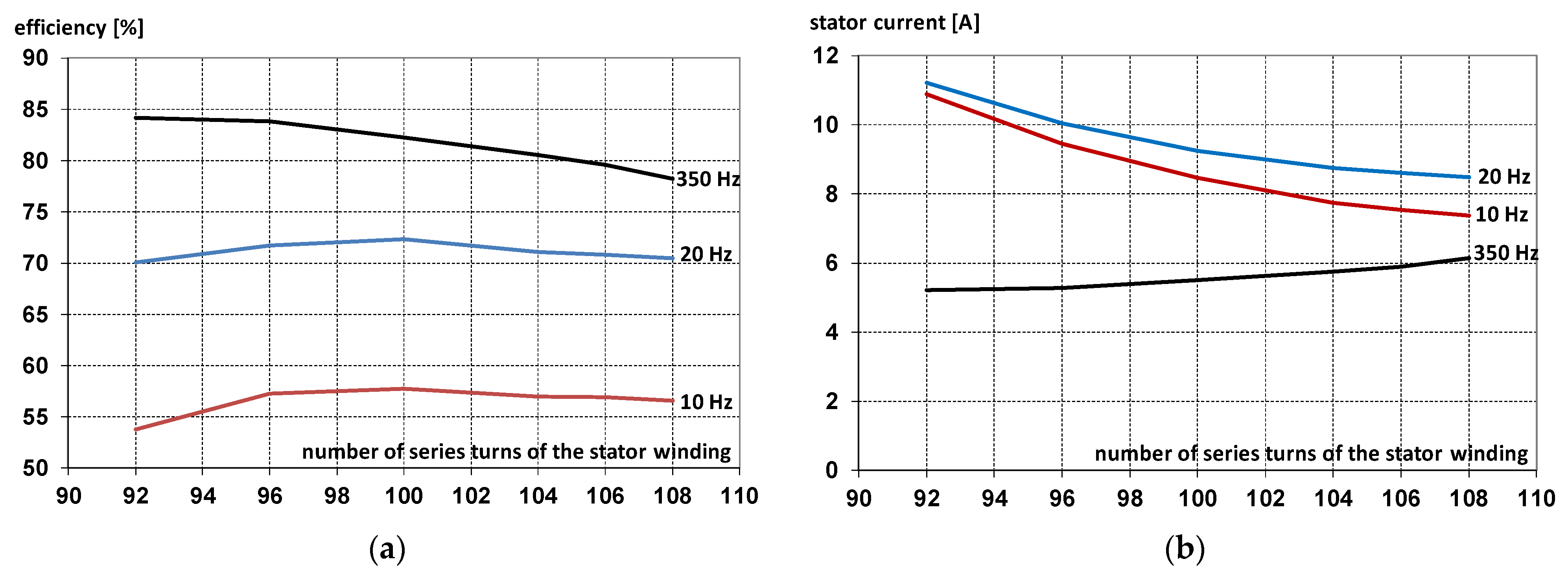

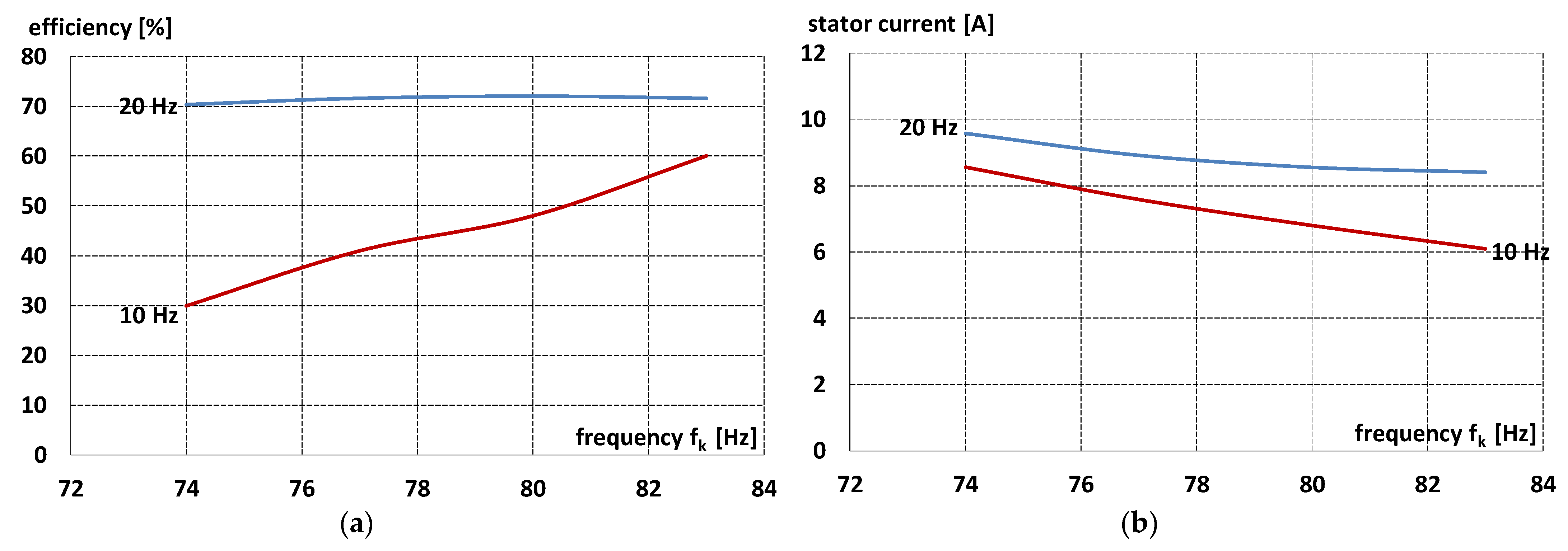

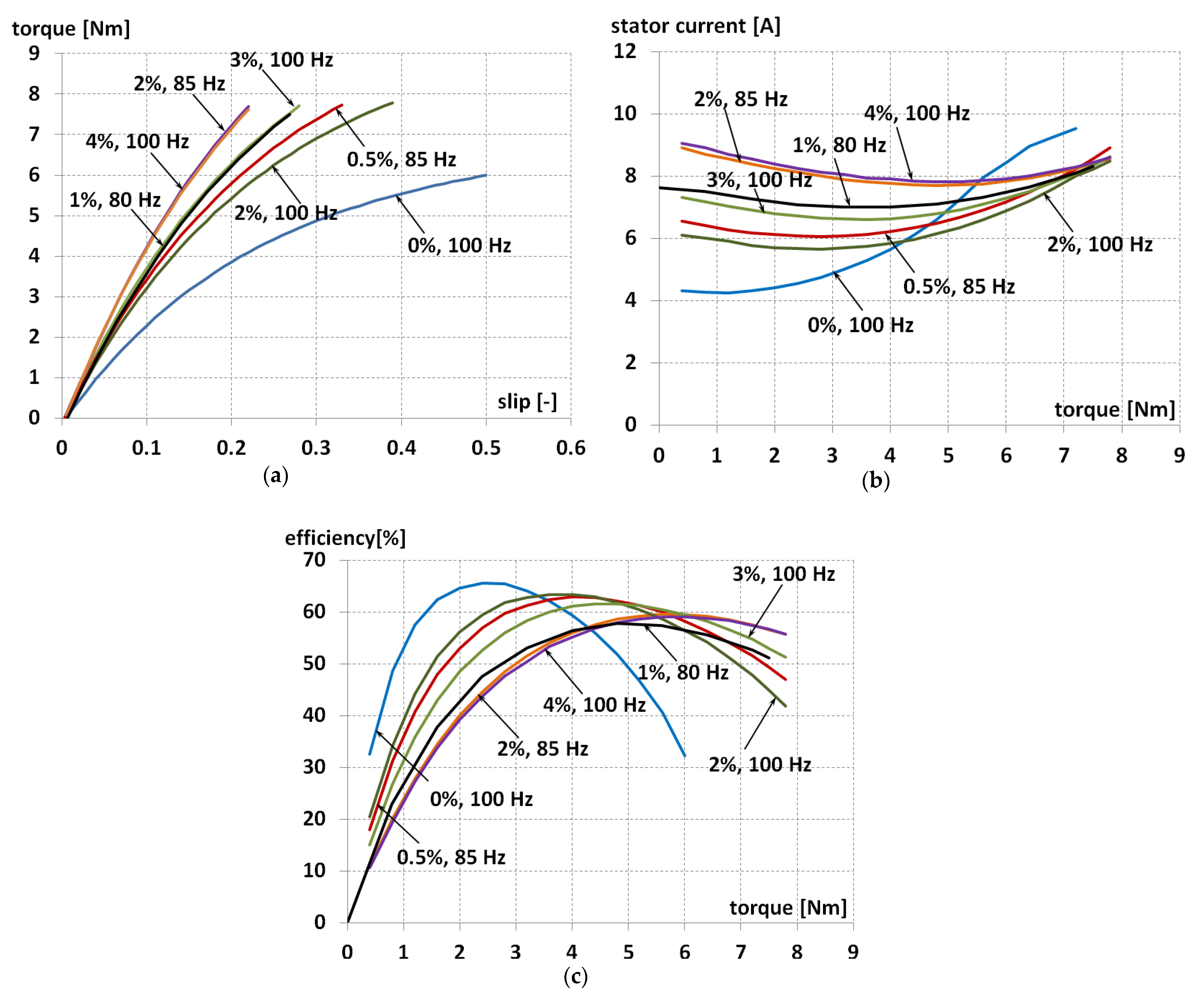

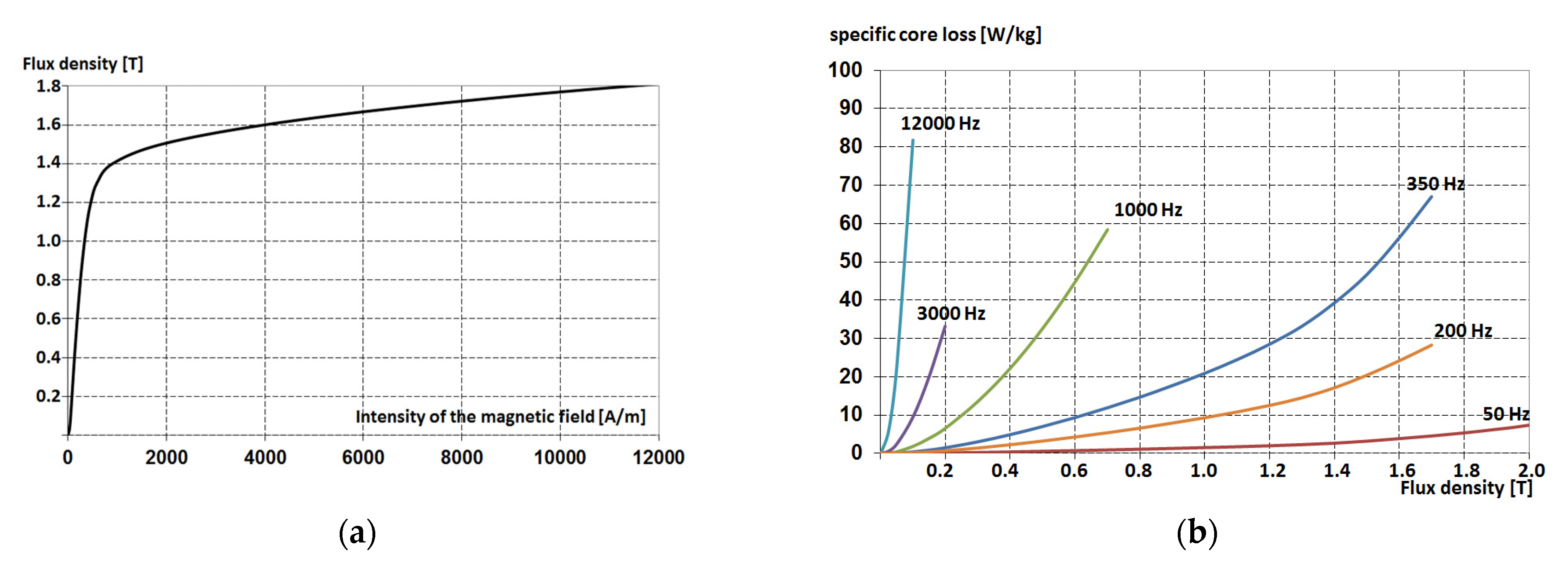


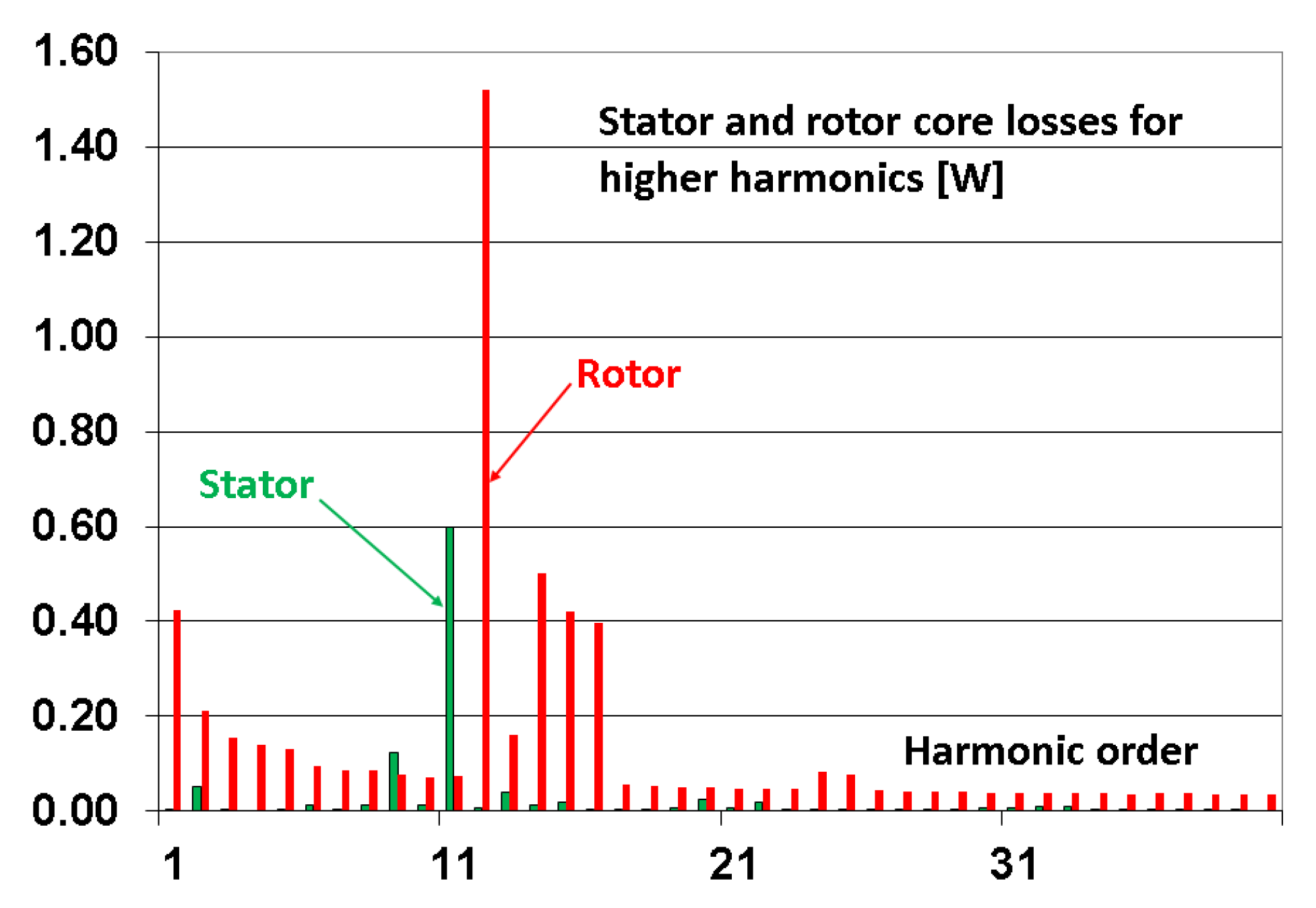

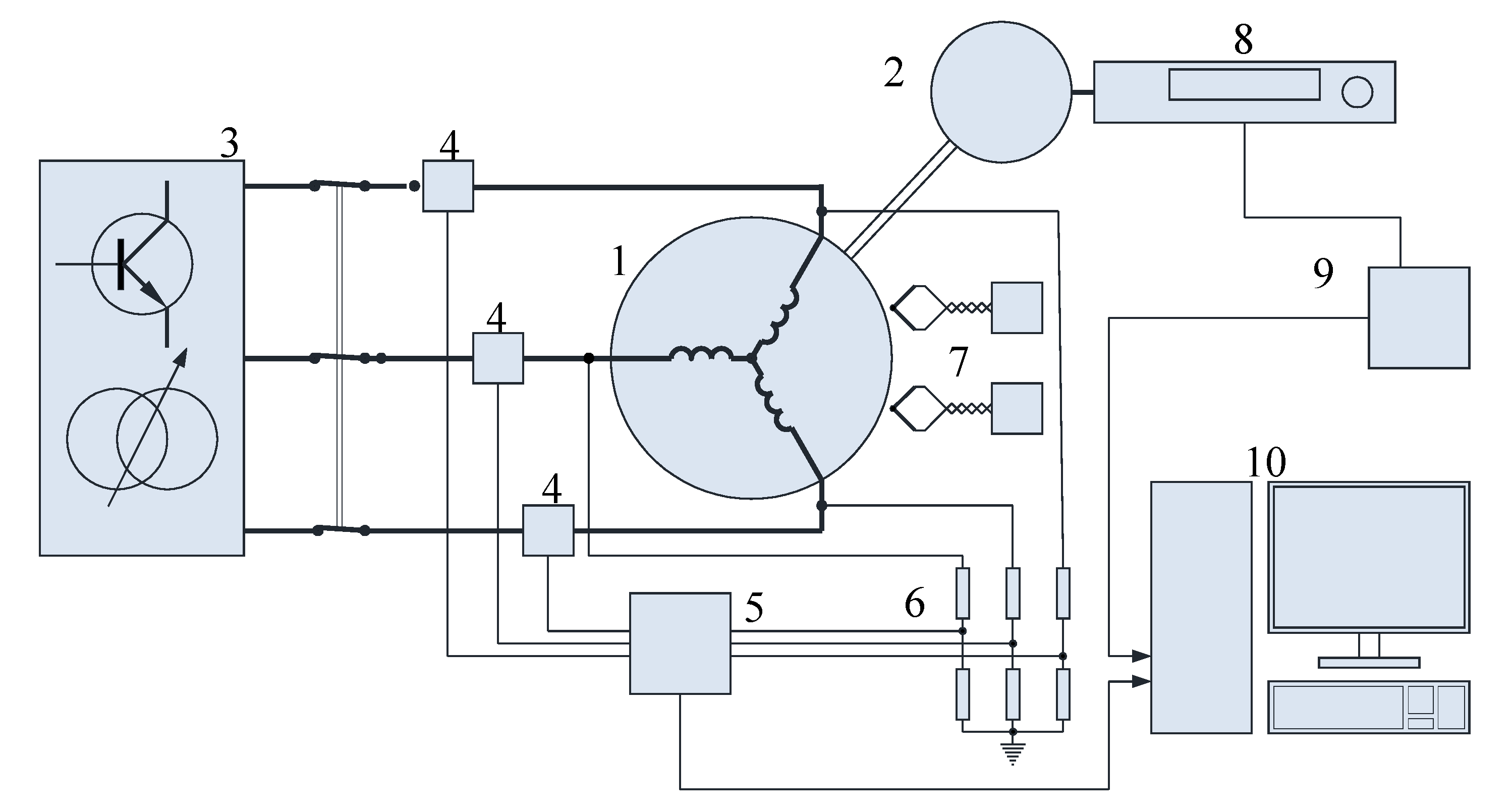

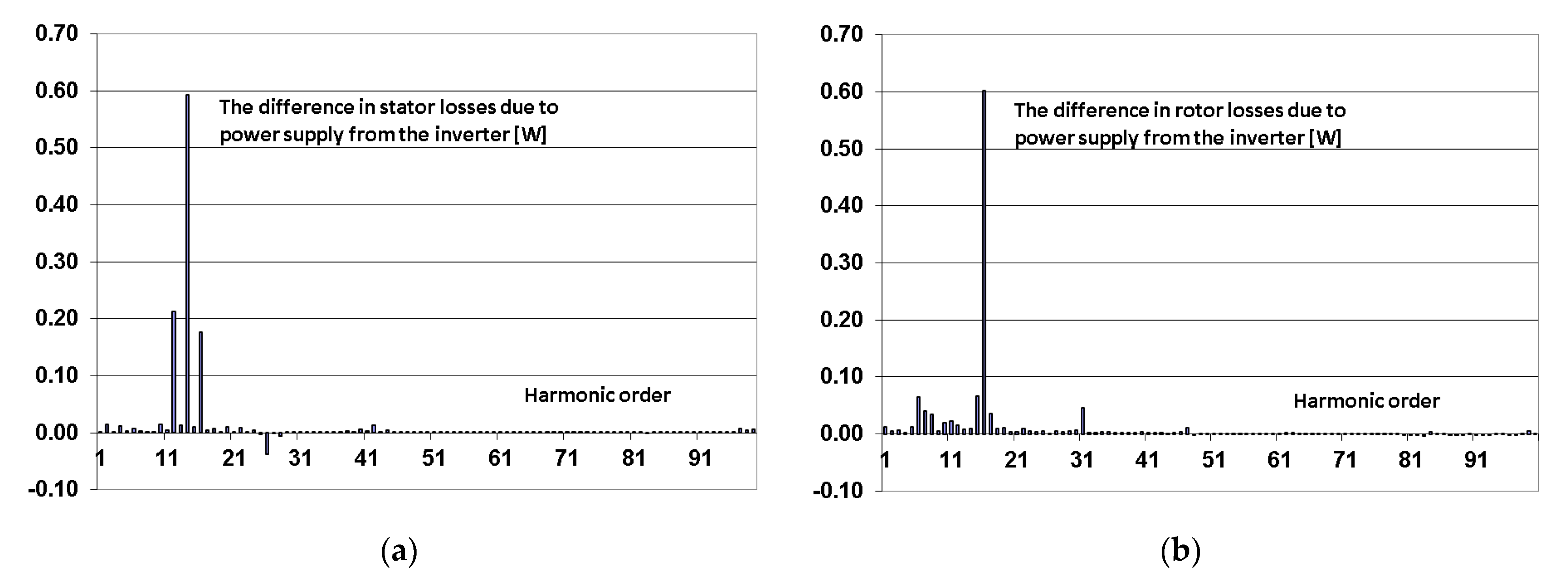
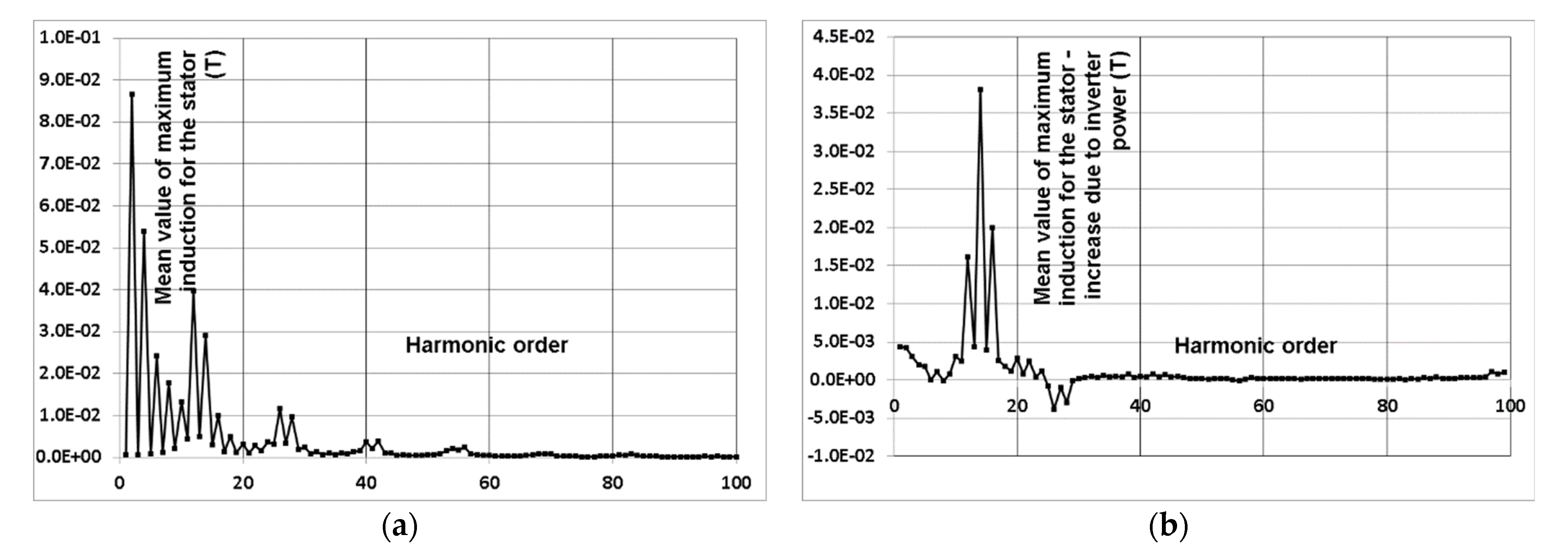
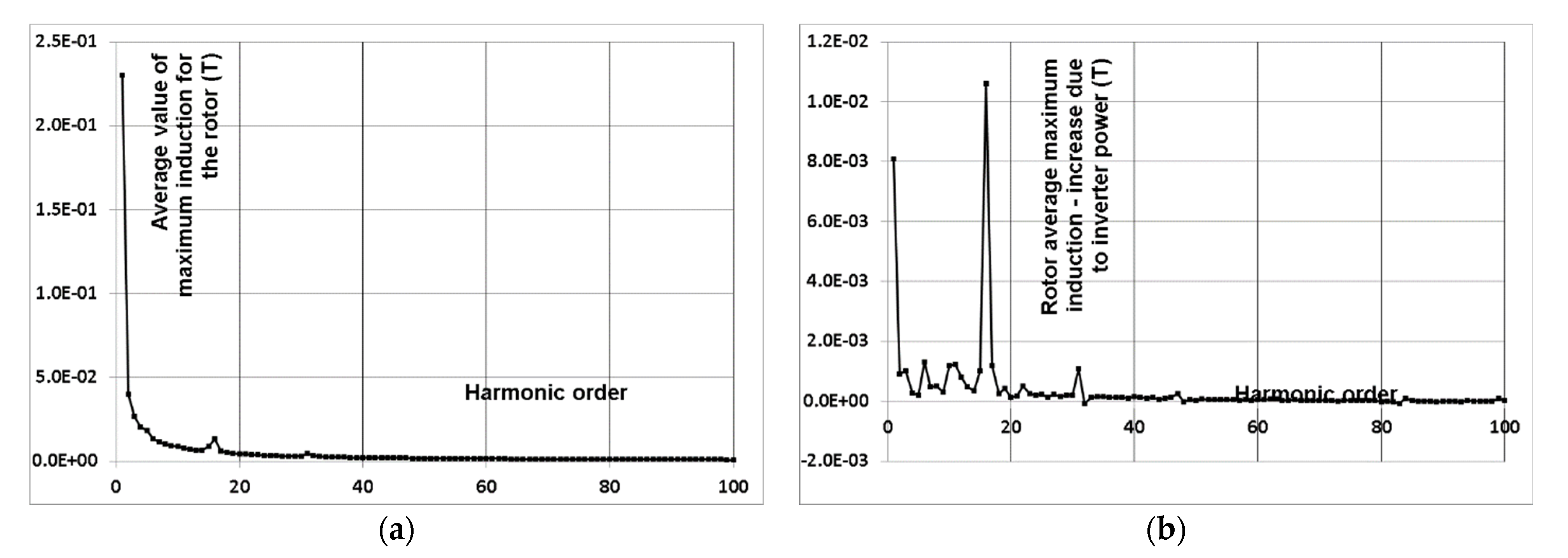

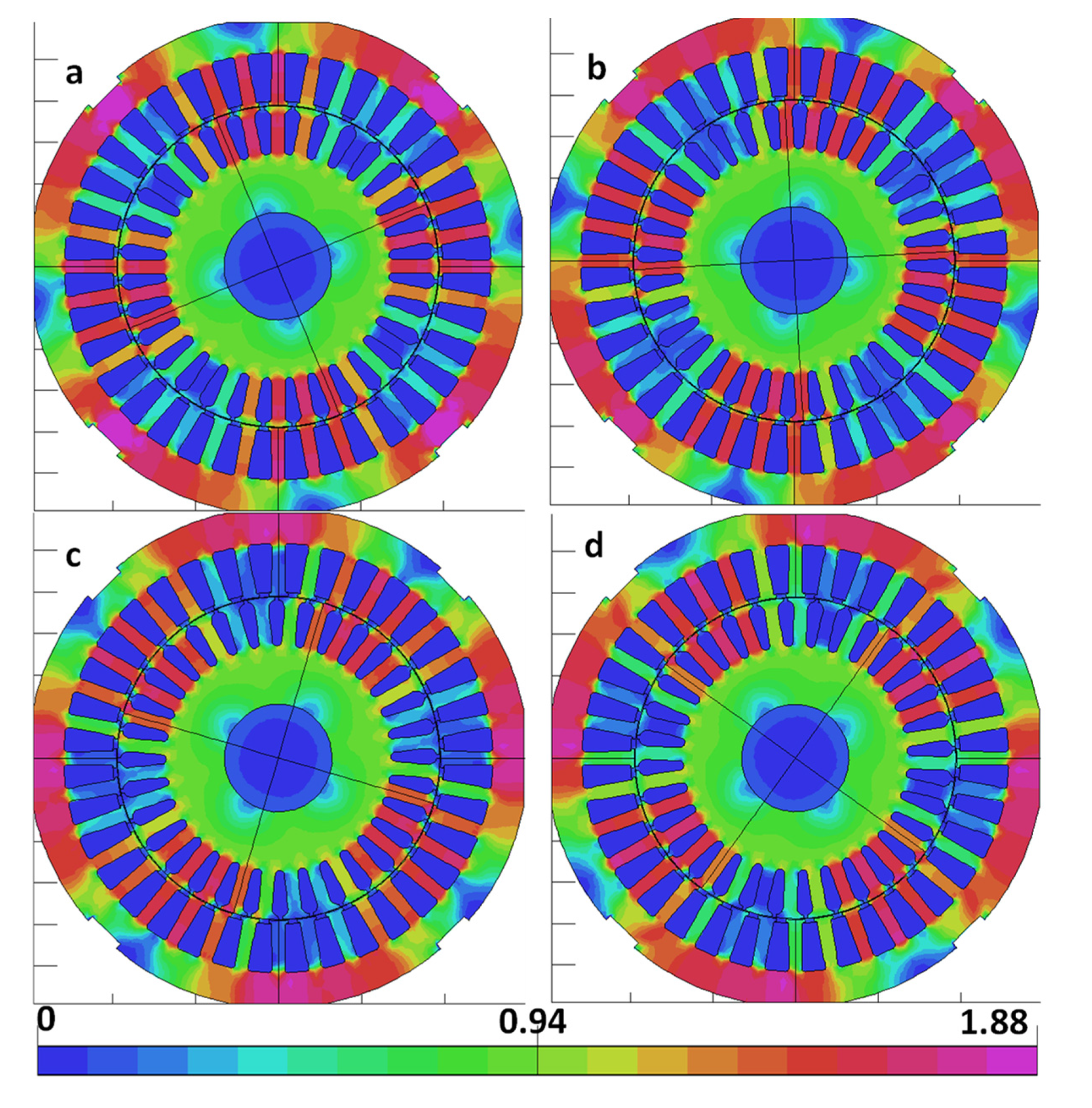
| f Hz | Torque Nm | Rotor Speed rpm |
|---|---|---|
| 10 | 7.6 | 211 |
| 20 | 9.1 | 487 |
| 350 | 1.3 | 10,087 |
| Boost | fk | U0 | U (for 10 Hz) | U (for 20 Hz) |
|---|---|---|---|---|
| % | Hz | V | V | V |
| 0 | 100 | 0 | 23.0 | 46.0 |
| 0.5 | 85 | 1.15 | 28.1 | 55.0 |
| 1.0 | 80 | 2.3 | 30.8 | 59.2 |
| 2.0 | 85 | 4.6 | 31.1 | 57.6 |
| 2.0 | 100 | 4.6 | 27.1 | 49.7 |
| 3.0 | 100 | 6.9 | 29.2 | 51.5 |
| 4.0 | 100 | 9.2 | 31.3 | 53.4 |
| Output | Efficiency | Efficiency Class for 50 Hz | |||||
|---|---|---|---|---|---|---|---|
| f Hz | Torque Nm | Power [W] | SK135/120 % | Existing Motor % | IE1 % | IE2 | IE3 |
| 10 | 7.6 | 170 | 54.7 | 42.1 | 56.5 | 64.5 | 69.5 |
| 20 | 9.1 | 500 | 69.0 | 61.5 | 69.0 | 76.0 | 80.0 |
| 350 | 1.3 | 1400 | 85.7 | 76.9 | 76.7 | 82.5 | 85.5 |
| Data | Symbol | Unit | SK135/120 |
|---|---|---|---|
| Stator outer diameter | Dse | mm | 135 |
| Stator inner diameter | Dsi | mm | 77 |
| Rotor inner diameter | Dri | mm | 26 |
| Core length | Ls | mm | 120 |
| Air gap thickness | δ | mm | 0.3 |
| Model | Stator Winding | Rotor Winding | Motor Core |
|---|---|---|---|
| (W) | (W) | (W) | |
| circuit | 86.5 | 64.6 | 11.7 |
| field-circuit | 89.95 | 78.10 | 12.05 |
| measurements | 90.8 | 70.6 | 14.9 |
| Model | Stator Winding | Rotor Winding | Motor Core |
|---|---|---|---|
| (W) | (W) | (W) | |
| circuit | 91.6 | 52.0 | 31.9 |
| field-circuit | 81.7 | 69.82 | 38.75 |
| measurements | 94.6 | 57.2 | 33.2 |
Publisher’s Note: MDPI stays neutral with regard to jurisdictional claims in published maps and institutional affiliations. |
© 2022 by the authors. Licensee MDPI, Basel, Switzerland. This article is an open access article distributed under the terms and conditions of the Creative Commons Attribution (CC BY) license (https://creativecommons.org/licenses/by/4.0/).
Share and Cite
Dems, M.; Komeza, K.; Szulakowski, J.; Kubiak, W. Increase the Efficiency of an Induction Motor Feed from Inverter for Low Frequencies by Combining Design and Control Improvements. Energies 2022, 15, 530. https://doi.org/10.3390/en15020530
Dems M, Komeza K, Szulakowski J, Kubiak W. Increase the Efficiency of an Induction Motor Feed from Inverter for Low Frequencies by Combining Design and Control Improvements. Energies. 2022; 15(2):530. https://doi.org/10.3390/en15020530
Chicago/Turabian StyleDems, Maria, Krzysztof Komeza, Jacek Szulakowski, and Witold Kubiak. 2022. "Increase the Efficiency of an Induction Motor Feed from Inverter for Low Frequencies by Combining Design and Control Improvements" Energies 15, no. 2: 530. https://doi.org/10.3390/en15020530






